We open the cards: why the HEPA filter in the air cleaner does not need an efficiency of 99.95%
Manufacturers love to write about the high efficiency of their air purifiers - 99.95% and above. Users are impressed by these numbers, and the large price tag for such devices seems justified. Is it so? Physics says that an efficiency of 95% is sufficient for a cleaner-recirculator . There is less such a cleaner, while its real effectiveness is the same. And all these nine decimal places - no more than a marketing ploy.
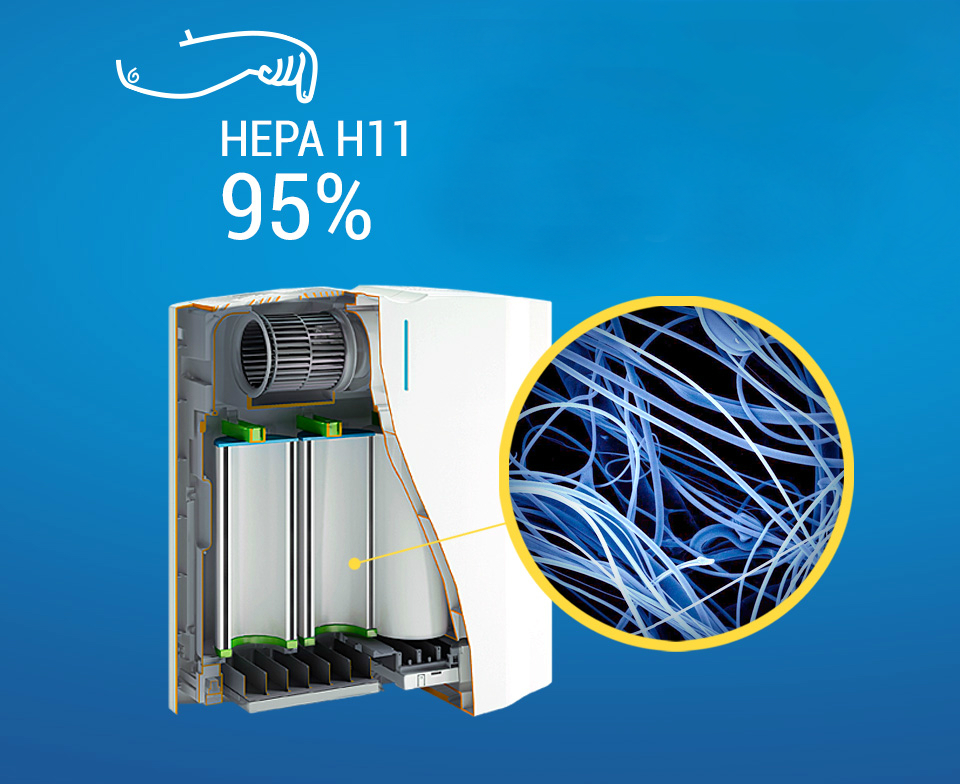
Immediately we denote an important point. HEPA filters are in vacuum cleaners, air ventilation, even air conditioners. But this article is about air purifiers. They work in recycling mode: they drive the same room air. Below it is about the recirculator cleaners.
')
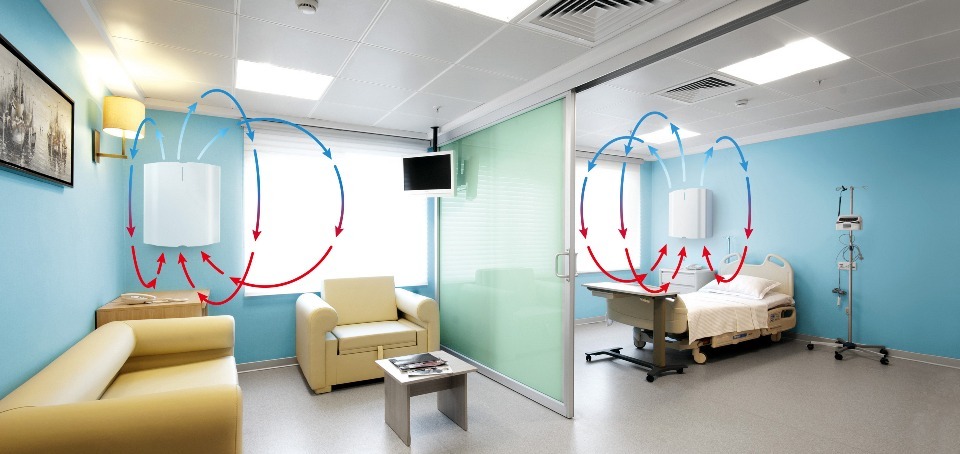
Particles are conventionally divided into large (more than 10 microns), small (from 1 to 10 microns) and smallest (less than 1 micron). The smallest and smallest particles up to 2.5 microns in size, the so-called PM2.5, are the most dangerous. This is proven by both scientific and statistical studies. They formed the basis of the recommendations of the World Health Organization, according to which PM2.5 particles are among the most dangerous air pollutants.
The coarse filter retains only large particles, with an efficiency of 65-90%. But for PM2.5 its efficiency will be almost zero. Only the HEPA filter can hold these particles. We already wrote why.
There is no doubt that the HEPA filter is a mandatory element of a modern air cleaner. The question is, what kind of efficiency should it have?
Manufacturers of air purifiers have a marketing ploy: to mix the concepts of filter efficiency, single-pass instrument efficiency and air purification efficiency. These are actually different things, and it is important to understand the differences between them.
Remove the HEPA filter from the cleaner and place it in a special aerosol stand. This is our stand AS-1:
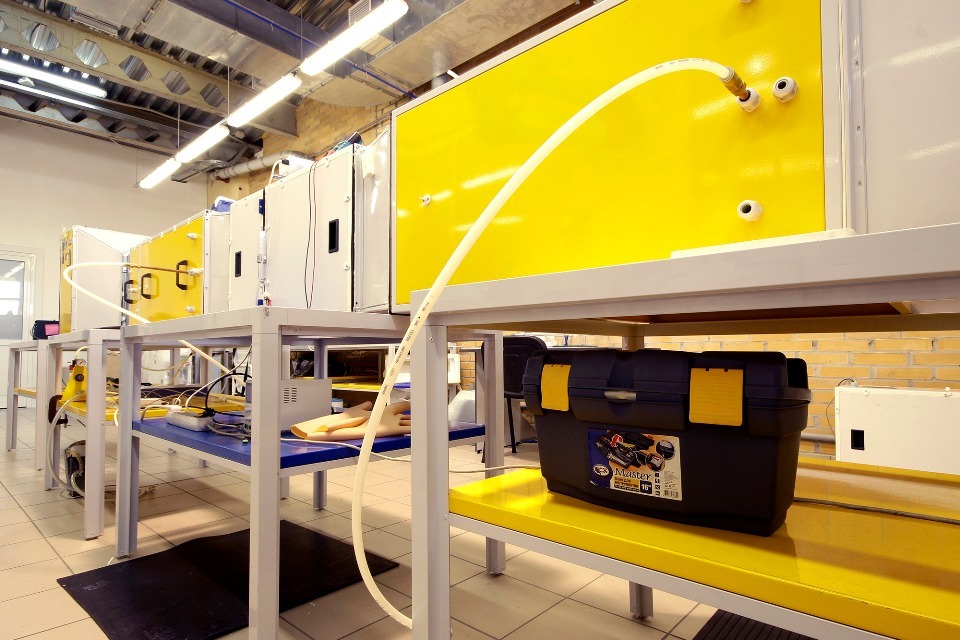
An aerosol simulating air pollutants is supplied to the stand. HEPA filter is fixed in the stand tightly. Therefore, the air flow with particles only one way - through the filter. The particle counter measures the concentration at the inlet to the filter and at the exit from it. We correlate the values and get the efficiency coefficient of the HEPA filter:
E filter = (N input filter - N output filter ) / N input filter
Multiply the coefficient by 100% and get the filter efficiency. For different classes of HEPA filters, the efficiency is different:
We will conduct the same experiment, only now we will put in the aerosol stand not a filter, but the entire air cleaner. We also correlate the concentration of particles at the entrance to the device and at the exit from it. We get the one-pass effectiveness of the cleaner:
E = (N input - N output ) / N input
If the filter was mounted in the device absolutely tightly and there were no gaps in the device itself, then the one-pass efficiency of the cleaner and the efficiency of the filter would be equal. But usually this does not happen.
In the cleaners air filters are replaceable. For them, there are special slots, filters are inserted and removed manually. If you do not ensure proper sealing in the attachment points, the air will go through the slots bypassing the filter. The case itself, often a composite of plastic parts, may also contain cracks. Naturally, all of this affects the single-pass efficiency of the cleaner. The higher the target efficiency, the more difficult it is to provide the desired tightness.
A case in point is our experience with medical laminar fields. If in the case of a laminar cell with a target efficiency of H14 (99.995%) there is at least one hole the size of a needle eye, then its one-pass efficiency will drop by the order: 99.995% -> 99.95%. That is, the leakage of particles will increase by 10 times 0.005% -> 0.05%.
In household solutions it is very difficult to ensure such precision tightness. At least, we have not yet come across a home air purifier with a real one-pass efficiency of H13 or H14. Although the manufacturers of this class of filters regularly announce in their devices.
There is a huge difference between experiments on an aerosol test bench and instrument operation in real conditions. The most important thing for us is the cleanliness of the air not at the outlet of the purifier, but in the room as a whole. The clean air coming out of the device is immediately mixed with the dirty air of the room, not displacing, but “diluting” it.
In this room, in addition to the purifier, there are other factors affecting the concentration of particles in the air. It decreases due to the natural sedimentation of particles and increases due to sources (people, pets, open window, books, carpets, furniture, etc.). In addition, in the room the air passes through the purifier not once, but several. And with each pass on the filter more and more particles settle, and the air becomes cleaner. And the more air is pumped through the filter at a time, the higher the cleaning efficiency. Therefore, not only the filter class, but also the performance of the device affects the real efficiency of air purification.
Imagine that the air cleaner has a single pass efficiency of 100%. But the fan to it is so weak that the performance of the device is close to zero. This cleaner does not drive the air through the filter, and therefore does not clean it. In the reverse situation, the result is the same: super powerful fan + zero one-pass efficiency = zero cleaning efficiency.
It turns out that the efficiency of air purification depends simultaneously on the single-pass efficiency of the device and on the performance of the fan. To assess the real efficiency of air purification, one must look for a reasonable combination of these two parameters. This combination is called CADR (Clean Air Delivery Rate).
In the early 1980s, the American Association of Home Appliance Manufacturers (AHAM) introduced CADR, an indicator to measure the real effectiveness of indoor air purifiers. The efficiency of air purification determines precisely the CADR, and not the nine decimal points or marketing tricks from manufacturers of the “nano-bio-ultra-filter” type.
In mathematical terms, CADR is the product of the single-pass efficiency of the cleaner and its performance:
CADR = E * Q
Fact number 1: CADR is more dependent on the performance of the cleaner than on the number of nines after the decimal point in filter efficiency
Suppose we have a cleaner with a capacity of 100 m3 / h. We insert into it the HEPA filter H11 (E = 0.95). We get CADR = 95. Increase productivity by 2 times. Now CADR is twice as much = 190.
Now replace the filter on H13 (E = 0.9995). For a capacity of 100 m3 / h CADR = 99.95. The filter efficiency increased by 2 orders of magnitude, and CADR practically did not change.
Fact number 2: CADR can not be more performance
The effectiveness of the device can not be more than 100%. In the classification of filters, the most effective is the U18 ULPA filter with an efficiency of 99.9999995%. Therefore, at best, CADR = 0.999999995 * Q.
Fact number 3: CADR depends on the type of pollutant.
CADR depends on the single pass efficiency of the cleaner. And it depends on the efficiency of the filters. And the effectiveness of the filter depends on the type of pollutant. In the last article about HEPA we said that this filter delays small and large particles in different ways. For PM2.5 particles, there will be one efficiency, for PM10 particles - another, and for volatile organic compounds - it will be completely zero (HEPA delays only particles, but not gas molecules).
But the carbon filter cleans the gases, but it doesn’t hold the particles well. Therefore, a cleaner with a specific filter set will have a different CADR for different types of pollutants. Association AHAM conducts independent research of household cleaners and, following their results, issues such CADR stickers for various pollutants:
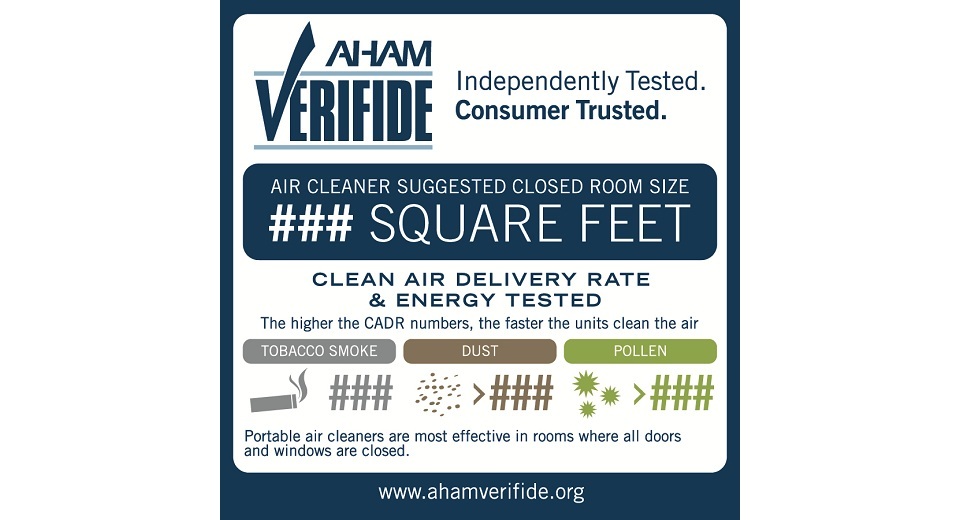
For simplicity and clarity, we will focus on one type of pollutant - PM2.5. Further in the text we will talk about CADR for these particles.
Imagine an isolated room with perfect conditions. The air exchange is uniform, that is, in any part of the room the concentration of PM2.5 particles is the same. They do not settle on the walls and the floor, and there are no sources of particles. There is a recirculator cleaner installed in the room. There is no influx, the device cleans only the air that is already in the room. This is the only factor that changes the concentration of particles in our ideal room. In physics, such a room is called the “perfect mixing reactor”.
If the device is turned off, the concentration of particles in the room air will be constant. If the cleaner is turned on, the concentration drops. And the longer the device works, the less particles will remain in the air. The concentration of particles decreases exponentially with time:
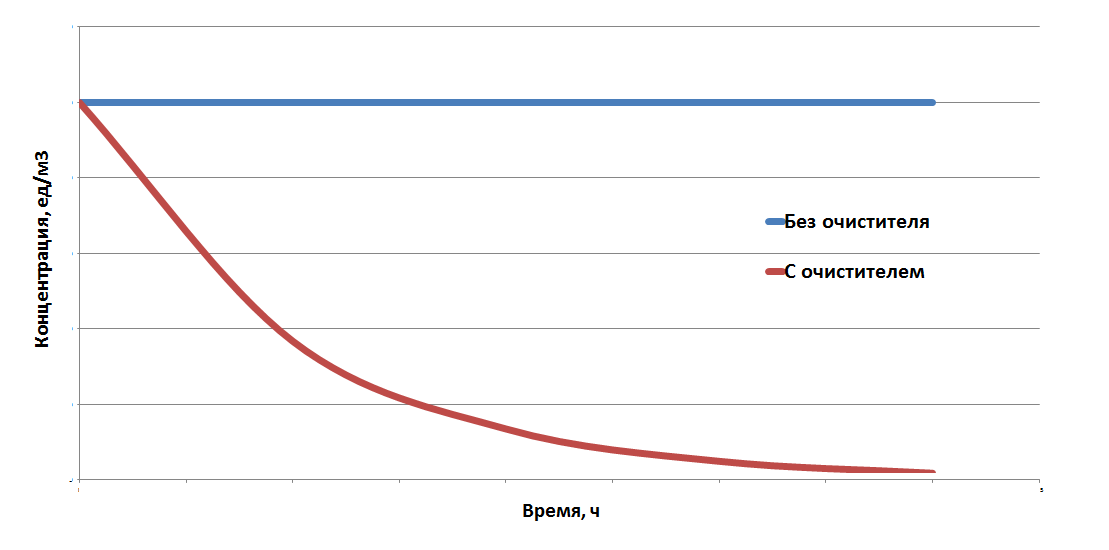
The exponent is described by the formula:
N t = N 0 * exp (- E * Q * t / V)
But the product E * Q is CADR:
N t = N 0 * exp (- CADR * t / V)
The exponent indicator is the ratio of the CADR to the volume of the room V. It means that it determines the characteristic time of cleaning the room:
t ~ V / CADR
To understand the relationship between CADR and the real efficiency of the device, let's set the parameters:
These parameters remain unchanged, in the formula we change only the CADR and see how many particles remain in the room in an hour.
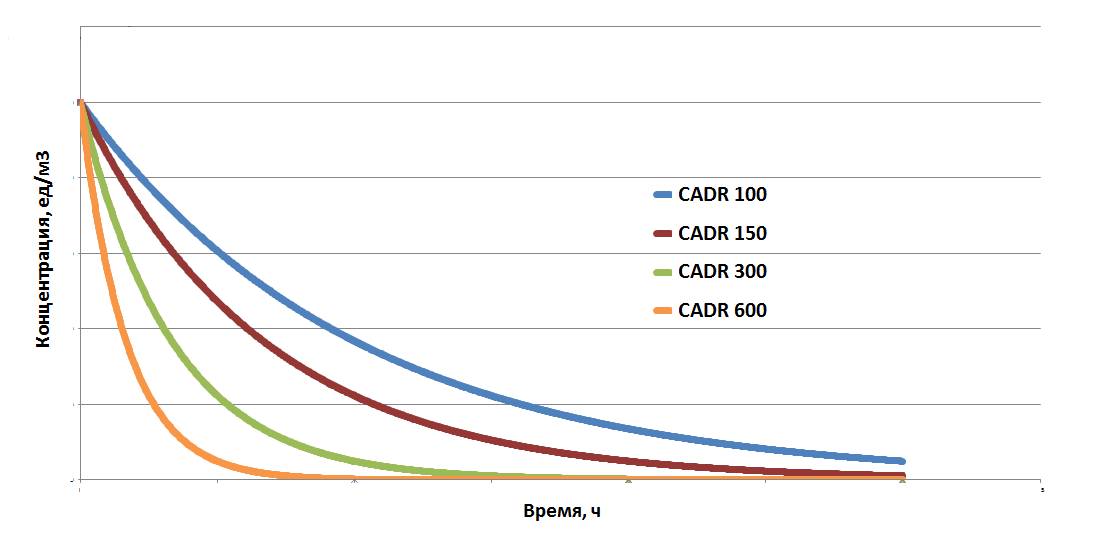
Can measure CADR directly. One-pass efficiency of the device is measured on an aerosol stand and multiplied by the performance of the device. This is the most accurate way to measure CADR. But aerosol stands in Russia can be counted on the fingers, so it will be difficult to calculate CADR directly.
Association AHAM proposed a simplified method. In it, CADR is not measured directly, but through measuring directly the efficiency of air purification. At the same time, it is not necessary to know either the single-pass efficiency of the device or the performance.
Measure the CADR of the cleaner according to PM2.5 using a simplified procedure.
We put the cleaner into the isolated room, but do not turn it on yet. We inject some amount of aerosol from PM2.5 into room air. We measure the concentration of particles at different times: in a minute, 10 minutes, half an hour, 45 minutes, an hour, two, and so on.
Ventilate the room and re-fill the same amount of PM2.5. Turn on the cleaner. We measure the concentration of particles in the air at the same time intervals.
We get two series of measurements: without a cleaner and with a cleaner. The data obtained is approximated by an exponent.
The first exhibitor shows the natural deposition of particles on the walls and floor. The second is natural sedimentation and sedimentation of particles in a purifier.
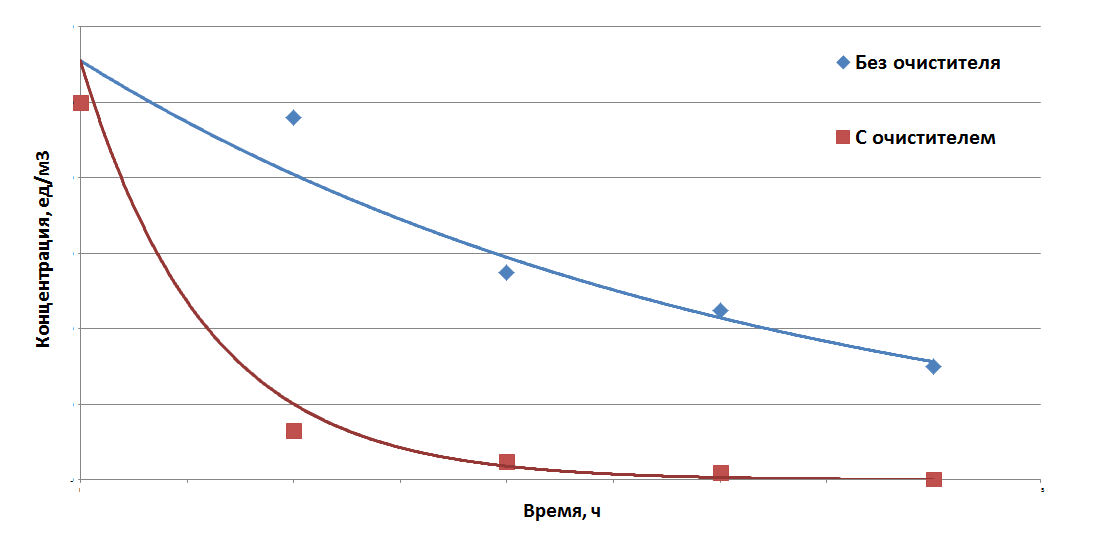
Subtract one from the other and get the final exponent of the deposition of particles in the cleaner. We find the exponent indicator: (- CADR / V) . The volume of the room we know, calculate the CADR easily.
This method of measurement is less accurate than on an aerosol test bench. But it is much easier. The error can be reduced by conducting a large series of measurements.
In the USA and China, manufacturers are obliged to indicate CADR of air purifiers. In Russia, this is not yet. We measured our cleaner's CADR on our own initiative.
We tested the effectiveness of Tion Clever on the AC-1 aerosol stand. For a fine aerosol with PM2.5 particles, the single-pass instrument efficiency is greater than 95%. Productivity of the device is 150 m3 / h. We get CADR = 142.5.
Tion Clever was designed to disinfect air in medical wards and cabinets. Its CADR meets the medical requirements for ensuring the sterility of air in medical institutions. One Tion Clever will provide a three-time air exchange in rooms of about 50 m3, that is, an area of about 20 m2. For larger areas, several devices are installed.
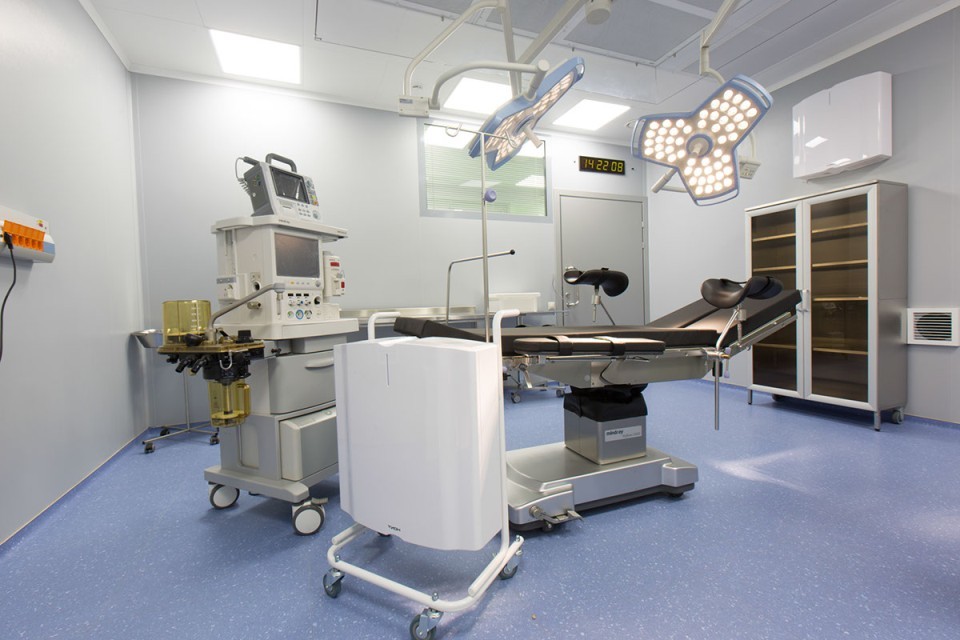
In the photo are two Tion Clever in the operating unit of a Moscow hospital: one on the wall, the other on the mobile stand.
Most importantly, choose a cleaner with a HEPA filter. Further selection depends on whether the CADR is specified on the instrument itself.
Calculate the volume of the room in which you plan to put the air purifier. Multiply it by 3. CADR cleaner should not be less than the obtained value.
In the characteristics, as a rule, indicates the maximum performance of the cleaner in the turbo mode. The cleaner in this mode is usually very noisy, so the user rarely turns it on. Come to the store and listen with your ears at all speeds. Choose a suitable speed with a comfortable noise level - it will correspond to the performance for calculating CADR.
And once again: do not chase after nine decimal points in efficiency.
Air purifiers (recirculators) - is another matter.They take the air not from the street, but from the room, clean and dilute the dirty air with clean air. For them, it is not the efficiency of the filter or device itself that is important, but CADR is important. And in fact, HEPA filters with an efficiency of 95% and 99.95% (with the same productivity of the cleaner) show almost the same time to clean the room. And if so, why pay more?
Thanks for attention!
If the topic is of interest, we will tell about the technology of active HEPA filtering in the Tion Clever cleaner.


Immediately we denote an important point. HEPA filters are in vacuum cleaners, air ventilation, even air conditioners. But this article is about air purifiers. They work in recycling mode: they drive the same room air. Below it is about the recirculator cleaners.
')

Why exactly HEPA filter?
Particles are conventionally divided into large (more than 10 microns), small (from 1 to 10 microns) and smallest (less than 1 micron). The smallest and smallest particles up to 2.5 microns in size, the so-called PM2.5, are the most dangerous. This is proven by both scientific and statistical studies. They formed the basis of the recommendations of the World Health Organization, according to which PM2.5 particles are among the most dangerous air pollutants.
The coarse filter retains only large particles, with an efficiency of 65-90%. But for PM2.5 its efficiency will be almost zero. Only the HEPA filter can hold these particles. We already wrote why.
There is no doubt that the HEPA filter is a mandatory element of a modern air cleaner. The question is, what kind of efficiency should it have?
Three efficiencies
Manufacturers of air purifiers have a marketing ploy: to mix the concepts of filter efficiency, single-pass instrument efficiency and air purification efficiency. These are actually different things, and it is important to understand the differences between them.
Filter efficiency
Remove the HEPA filter from the cleaner and place it in a special aerosol stand. This is our stand AS-1:
An aerosol simulating air pollutants is supplied to the stand. HEPA filter is fixed in the stand tightly. Therefore, the air flow with particles only one way - through the filter. The particle counter measures the concentration at the inlet to the filter and at the exit from it. We correlate the values and get the efficiency coefficient of the HEPA filter:
E filter = (N input filter - N output filter ) / N input filter
Multiply the coefficient by 100% and get the filter efficiency. For different classes of HEPA filters, the efficiency is different:
- H10 - 85%
- H11 - 95%
- H12 - 99.5%
- H13 - 99.95%
- H14 - 99.995%
Single Pass Purifier Performance
We will conduct the same experiment, only now we will put in the aerosol stand not a filter, but the entire air cleaner. We also correlate the concentration of particles at the entrance to the device and at the exit from it. We get the one-pass effectiveness of the cleaner:
E = (N input - N output ) / N input
If the filter was mounted in the device absolutely tightly and there were no gaps in the device itself, then the one-pass efficiency of the cleaner and the efficiency of the filter would be equal. But usually this does not happen.
In the cleaners air filters are replaceable. For them, there are special slots, filters are inserted and removed manually. If you do not ensure proper sealing in the attachment points, the air will go through the slots bypassing the filter. The case itself, often a composite of plastic parts, may also contain cracks. Naturally, all of this affects the single-pass efficiency of the cleaner. The higher the target efficiency, the more difficult it is to provide the desired tightness.
A case in point is our experience with medical laminar fields. If in the case of a laminar cell with a target efficiency of H14 (99.995%) there is at least one hole the size of a needle eye, then its one-pass efficiency will drop by the order: 99.995% -> 99.95%. That is, the leakage of particles will increase by 10 times 0.005% -> 0.05%.
In household solutions it is very difficult to ensure such precision tightness. At least, we have not yet come across a home air purifier with a real one-pass efficiency of H13 or H14. Although the manufacturers of this class of filters regularly announce in their devices.
Manufacturers in the characteristics of the cleaner "stick out" greater efficiency of the HEPA filter. While the single-pass efficiency of the entire instrument is almost always lower. We tested instruments with HEPA filter H14, which actually had a single pass efficiency of 50%.
Air purification efficiency
There is a huge difference between experiments on an aerosol test bench and instrument operation in real conditions. The most important thing for us is the cleanliness of the air not at the outlet of the purifier, but in the room as a whole. The clean air coming out of the device is immediately mixed with the dirty air of the room, not displacing, but “diluting” it.
In this room, in addition to the purifier, there are other factors affecting the concentration of particles in the air. It decreases due to the natural sedimentation of particles and increases due to sources (people, pets, open window, books, carpets, furniture, etc.). In addition, in the room the air passes through the purifier not once, but several. And with each pass on the filter more and more particles settle, and the air becomes cleaner. And the more air is pumped through the filter at a time, the higher the cleaning efficiency. Therefore, not only the filter class, but also the performance of the device affects the real efficiency of air purification.
The capacity of the purifier is the volume of air that the device pumps through itself per unit of time. It is denoted by the letter Q. We measured in m3 / h, in the west in ft3 / min.
1 ft3 / min ≈ 1.7 m3 / hour
Imagine that the air cleaner has a single pass efficiency of 100%. But the fan to it is so weak that the performance of the device is close to zero. This cleaner does not drive the air through the filter, and therefore does not clean it. In the reverse situation, the result is the same: super powerful fan + zero one-pass efficiency = zero cleaning efficiency.
It turns out that the efficiency of air purification depends simultaneously on the single-pass efficiency of the device and on the performance of the fan. To assess the real efficiency of air purification, one must look for a reasonable combination of these two parameters. This combination is called CADR (Clean Air Delivery Rate).
What is CADR
In the early 1980s, the American Association of Home Appliance Manufacturers (AHAM) introduced CADR, an indicator to measure the real effectiveness of indoor air purifiers. The efficiency of air purification determines precisely the CADR, and not the nine decimal points or marketing tricks from manufacturers of the “nano-bio-ultra-filter” type.
"Clean air delivery rate" is translated as "clean air flow rate." The meaning of the indicator is simple. If the cleaner delivers 100 m3 / h and its single-pass efficiency is 50%, then the flow rate of clean air is 50 m3 / h. The more CADR, the faster the device cleans the room air and updates it faster. Accordingly, it reduces the concentration of particles in the air faster.
In mathematical terms, CADR is the product of the single-pass efficiency of the cleaner and its performance:
CADR = E * Q
Three important facts about CADR
Fact number 1: CADR is more dependent on the performance of the cleaner than on the number of nines after the decimal point in filter efficiency
Suppose we have a cleaner with a capacity of 100 m3 / h. We insert into it the HEPA filter H11 (E = 0.95). We get CADR = 95. Increase productivity by 2 times. Now CADR is twice as much = 190.
Now replace the filter on H13 (E = 0.9995). For a capacity of 100 m3 / h CADR = 99.95. The filter efficiency increased by 2 orders of magnitude, and CADR practically did not change.
Fact number 2: CADR can not be more performance
The effectiveness of the device can not be more than 100%. In the classification of filters, the most effective is the U18 ULPA filter with an efficiency of 99.9999995%. Therefore, at best, CADR = 0.999999995 * Q.
Fact number 3: CADR depends on the type of pollutant.
CADR depends on the single pass efficiency of the cleaner. And it depends on the efficiency of the filters. And the effectiveness of the filter depends on the type of pollutant. In the last article about HEPA we said that this filter delays small and large particles in different ways. For PM2.5 particles, there will be one efficiency, for PM10 particles - another, and for volatile organic compounds - it will be completely zero (HEPA delays only particles, but not gas molecules).
But the carbon filter cleans the gases, but it doesn’t hold the particles well. Therefore, a cleaner with a specific filter set will have a different CADR for different types of pollutants. Association AHAM conducts independent research of household cleaners and, following their results, issues such CADR stickers for various pollutants:

For simplicity and clarity, we will focus on one type of pollutant - PM2.5. Further in the text we will talk about CADR for these particles.
How CADR Affects Real Cleaning Efficiency
Imagine an isolated room with perfect conditions. The air exchange is uniform, that is, in any part of the room the concentration of PM2.5 particles is the same. They do not settle on the walls and the floor, and there are no sources of particles. There is a recirculator cleaner installed in the room. There is no influx, the device cleans only the air that is already in the room. This is the only factor that changes the concentration of particles in our ideal room. In physics, such a room is called the “perfect mixing reactor”.
If the device is turned off, the concentration of particles in the room air will be constant. If the cleaner is turned on, the concentration drops. And the longer the device works, the less particles will remain in the air. The concentration of particles decreases exponentially with time:
The exponent is described by the formula:
N t = N 0 * exp (- E * Q * t / V)
- N t - the concentration of particles at time t
- N 0 - the initial concentration of particles
- E - single-pass purifier efficiency
- Q - cleaner performance
- V - room volume
- t is the time of the cleaner
But the product E * Q is CADR:
N t = N 0 * exp (- CADR * t / V)
The exponent indicator is the ratio of the CADR to the volume of the room V. It means that it determines the characteristic time of cleaning the room:
t ~ V / CADR
To understand the relationship between CADR and the real efficiency of the device, let's set the parameters:
- The initial concentration of particles N 0 = 100 units / m3
- Room volume V = 100 m3
- Cleaning time t = 1 h
These parameters remain unchanged, in the formula we change only the CADR and see how many particles remain in the room in an hour.
- CADR = 100
N = 100 * exp (-1) ≈ 36.8 u / m3
Air cleaning efficiency in 1 hour ≈ 63.2%Pay attention to a non-trivial fact. For example, in our room of 100 m3 there is a cleaner with a capacity of 100 m3 / h. That is, it provides a single air exchange. It turns out, in 1 hour the air in the room will be completely updated? Not. We have just shown that even with a 100% cleaning efficiency (CADR = Q) with a single air exchange, the cleaning efficiency of the room will be 63.2%. That is, the concentration will decrease by about 3 times, but not by ten and not by a hundred times!
- CADR = 150
N = 100 * exp (-1.5) ≈ 22.3 u / m3
Air cleaning efficiency in 1 hour ≈ 77.7% - CADR = 300
N = 100 * exp (-3) ≈ 5 units / m3
Air cleaning efficiency in 1 hour ≈ 95%From 95% and above - this is already a good cleaning efficiency. We received it with a triple air exchange (CADR = 300 m3 / h, V = 100 m3). So here's a simple tip: to determine the minimum CADR for your room, multiply its volume by three.
- CADR = 600
N = 100 * exp (-6) ≈ 0.25 U / m3
Air cleaning efficiency in 1 hour ≈ 99.75%
How to measure CADR cleaner
Can measure CADR directly. One-pass efficiency of the device is measured on an aerosol stand and multiplied by the performance of the device. This is the most accurate way to measure CADR. But aerosol stands in Russia can be counted on the fingers, so it will be difficult to calculate CADR directly.
Association AHAM proposed a simplified method. In it, CADR is not measured directly, but through measuring directly the efficiency of air purification. At the same time, it is not necessary to know either the single-pass efficiency of the device or the performance.
Measure the CADR of the cleaner according to PM2.5 using a simplified procedure.
We put the cleaner into the isolated room, but do not turn it on yet. We inject some amount of aerosol from PM2.5 into room air. We measure the concentration of particles at different times: in a minute, 10 minutes, half an hour, 45 minutes, an hour, two, and so on.
Ventilate the room and re-fill the same amount of PM2.5. Turn on the cleaner. We measure the concentration of particles in the air at the same time intervals.
We get two series of measurements: without a cleaner and with a cleaner. The data obtained is approximated by an exponent.
The first exhibitor shows the natural deposition of particles on the walls and floor. The second is natural sedimentation and sedimentation of particles in a purifier.
Subtract one from the other and get the final exponent of the deposition of particles in the cleaner. We find the exponent indicator: (- CADR / V) . The volume of the room we know, calculate the CADR easily.
This method of measurement is less accurate than on an aerosol test bench. But it is much easier. The error can be reduced by conducting a large series of measurements.
What is CADR Cleaner Tion Clever
In the USA and China, manufacturers are obliged to indicate CADR of air purifiers. In Russia, this is not yet. We measured our cleaner's CADR on our own initiative.
We tested the effectiveness of Tion Clever on the AC-1 aerosol stand. For a fine aerosol with PM2.5 particles, the single-pass instrument efficiency is greater than 95%. Productivity of the device is 150 m3 / h. We get CADR = 142.5.
Tion Clever was designed to disinfect air in medical wards and cabinets. Its CADR meets the medical requirements for ensuring the sterility of air in medical institutions. One Tion Clever will provide a three-time air exchange in rooms of about 50 m3, that is, an area of about 20 m2. For larger areas, several devices are installed.

In the photo are two Tion Clever in the operating unit of a Moscow hospital: one on the wall, the other on the mobile stand.
We offer you an elementary puzzle.
One Tion Clever is in a room of 20 m2 and a ceiling height of about 2.5 m. For simplicity, let's assume that there are no sources of particles in the room. How much time does Tion Clever reduce PM2.5 particle concentrations 100 times? That is, clean the air in the room by 99%.See solutionWe consider the volume of the room:
V = 20 m2 * 2.5 m = 50 m3
The initial concentration of PM2.5 particles in the air is N 0 . After time t, it should decrease 100 times:
N t = 0.01 * N 0
Concentration in the air varies according to the law:
N t = N 0 * exp (- CADR * t / V)
We substitute the known values and count the time after which the air will be cleaned by 99%:
0.01 * N 0 = N 0 * exp (- 142.5 * t / 50)
0.01 = exp (-2.85 * t)
ln (0.01) = -2.85 * t
-4.6 = -2.85 * t
t = 1.6
Answer: After about an hour and a half, Tion Clever cleans the air in the room by 99%.
Conclusion: tips on choosing an air purifier
Most importantly, choose a cleaner with a HEPA filter. Further selection depends on whether the CADR is specified on the instrument itself.
If the device is indicated CADR
Calculate the volume of the room in which you plan to put the air purifier. Multiply it by 3. CADR cleaner should not be less than the obtained value.
If the device is not specified CADR
- Try to evaluate CADR yourself. A conscientious manufacturer indicates in the characteristics of the cleaner and one-pass efficiency, and performance. Just multiply their values - and get a CADR. If the description of the device does not contain at least one of these parameters, it is worth considering: is it worth to trust such a manufacturer?
- Most often, the characteristics indicate the efficiency of the filter, and not the single-pass efficiency of the entire cleaner. Rate the build quality of the device. The filter should have a sufficiently rigid housing with a seal around the perimeter. The filter itself should sit tight in the housing. The remaining parts must also fit snugly together, a seal must be present at the joints of the split parts. If the device is assembled without visible gaps, then there is a chance that the one-pass efficiency of the entire device is close to the declared effectiveness of the filters.
In the characteristics, as a rule, indicates the maximum performance of the cleaner in the turbo mode. The cleaner in this mode is usually very noisy, so the user rarely turns it on. Come to the store and listen with your ears at all speeds. Choose a suitable speed with a comfortable noise level - it will correspond to the performance for calculating CADR.
And once again: do not chase after nine decimal points in efficiency.
Initially, HEPA filters were not designed for recirculators, but for single-pass air cleaning in ventilation. They are used in clean rooms in the medicine, pharmaceutical and electronics industries. In these areas, even single specks of dust or microbes in the air pose risks. The air supply there is designed so that the sterile air is not mixed with dirty, and displaces it. Therefore, one-pass efficiency should be as large as possible so that not a single part of the street gets from. This is where nines are needed after the decimal point. And each "honest" nine directly affects the cost of the filter and the entire device as a whole.
Air purifiers (recirculators) - is another matter.They take the air not from the street, but from the room, clean and dilute the dirty air with clean air. For them, it is not the efficiency of the filter or device itself that is important, but CADR is important. And in fact, HEPA filters with an efficiency of 95% and 99.95% (with the same productivity of the cleaner) show almost the same time to clean the room. And if so, why pay more?
Thanks for attention!
If the topic is of interest, we will tell about the technology of active HEPA filtering in the Tion Clever cleaner.

Source: https://habr.com/ru/post/368757/
All Articles